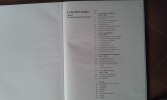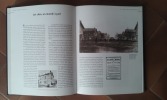-
Type
Book (21228)
Magazine (159)
Manuscript (4)
Old papers (8)
-
Latest
Last 24h (52)
Last 3 days (34)
Last month (292)
Last week (6)
-
Language
Dutch (2)
English (9)
Finnish (1)
French (21367)
German (10)
Italian (5)
Spanish (3)
Swedish (2)
-
Century
16th (10)
17th (28)
18th (280)
19th (973)
20th (11093)
21st (1732)
-
Countries
Belgium (1703)
Brazil (3)
Canada (6)
Côte d'Ivoire (51)
Denmark (233)
France (16960)
Greece (10)
Italy (219)
Netherlands (152)
Switzerland (2062)
-
Syndicate
ALAC (6)
CLAQ (2)
CNE (1)
ILAB (13394)
NVVA (1812)
SLACES (1660)
SLAM (11255)
SNCAO (5)
"La société à finalité sociale; un succès ou un coup dans l'eau ? Analyse des aspects juridiques et fiscaux."
Bruxelles, Editions Luc Pire, 2003. 15 x 21, 199 pp., broché, bon état (cachets ex- bibliothèque).
prix Roger Vanthournout.
ESSAI SUR LA NATURE DU COMMERCE EN GENERAL. Réimpression de l'édition de 1952 fondée sur le texte original de 1755 avec des études et commentaires revus et argumentés
INED 1998 in8. 1998. Cartonné jaquette.
livre en très bon état jaquette défraîchie un peu ternie petite déchirure sur le 4e plat
Essai sur la nature du commerce en général.
Paris, I. N. E. D., 1952 in-8, LXXII-192 pp., broché sous jaquette éditeur. Jaquette un peu défraîchie.
Texte de l'édition originale de 1755 avec des études et commentaires par Alfred Sauvy, Amintore Fanfani, Joseph J. Spengler et Louis Salleron. - - VENTE PAR CORRESPONDANCE UNIQUEMENT
Essai sur la Nature du Commerce en général. Traduit de l'anglois. - [THE FOUNDATION OF ECONOMIC THEORY]
A Londres, Chez Fletcher Gyles, dans Holborn, 1755. 12mo (binding ab. 17x10 cm). Bound in a very nice, contemporary full mottled calf binding with five raised bands to richly gilt spine. All edges of boards with a single gilt line-decoration. Beautiful marbled edges. Very neat and professional restorations to hinges and upper capital. A single tiny worm-hole to middle of spine and a supeficial, barely noticeable, crack down the middle. Old paper-label to lower compartment of spine. One corner a bit worn. Small ex libris to inside of front board, ex libris stamp to half-title. Contemporary owner's name crossed out at title-page. Internally exceptionally nice and clean. Small worm-hole to inner margin of about 60 leaves towards the end, only just touching the edge of a very few letters, otherwise not affecting lettering at all. (4), 430, (6, -Table des Chapitres) pp.
The exceedingly rare first edition of one of the most important and influential works of economic literature, as well as being one of the scarcest. The author is considered a pioneer of economic theory who anticipated and influenced the likes of Smith, Malthus, Turgot, Quesnay, Mirabeau, etc., etc. and this, his only published work (!), is considered the first actual work of theoretical economics, an absolutely ground-breaking work which by Jevons was characterized as the ""Cradle of Political Economy"".Richard Cantillon (1680-1734), though his name is probably of Spanish descent, was an Irishman, and he spent most of his life in France. He was a man of secrecy, and little is known about his life and work. He wrote his only published book, the seminal ""Essai sur la Nature du Commerce en Général"" between 1730 and 1734 but never saw it published, as he was murdered in 1734 (when he was robbed and his house was set on fire, presumably by his former cook whom he had dismissed ten days earlier), and the book had to await posthumous publication. There is evidence that Cantillon wrote much more than this single work, but the ""Essai"" seems to be the only one that survived the fire in his house on the night of his death. The work was finally published for the first time in French, anonymously, in 1755, and it is not known whether Cantillon actually wrote the manuscript in French and that the mention of translation on the title-page is false (e.g. to avoid French censorship), or whether he wrote the manuscript in English and translated it into French himself"" in all cases, the work circulated in French manuscript form, before it was published, and an English manuscript has never been found. ""In any case, the ""Essai"" is a work of genious, and it was undoubtedly written by Cantillon"" (Brewer, p. 19). After having had an immense influence on the Physiocrats and the French School, directly influencing Anne-Robert-Jacques Turgot , François Quesnay, Jean-Baptiste Say, Victor de Riquetti marquis de Mirabeau, Adam Smith, etc., the ""Essay…"" soon sank into obscurity only to be rediscovered by Jevons in the 1880'ies, and throughout the late 19th and the 20th century it has become increasingly evident that the present work is indeed a pioneering work, which directly and indirectly influenced almost all later economic theory. ""Richard Cantillon was a key figure in the early development of economics. He was one of the first to see economy as a single inter-connected system and to try to explain how it worked, and the first to present a coherent theory of prices and income distribution. He made major contributions to monetary theory and to the theory of balance of payments adjustment. The Physiocrats, writing only a few years after the (delayed) publication of Cantillon's one surviving work, the ""Essai sur la nature du commerce en general"", took many of their ideas very directly from it. Adam Smith probably learnt from Cantillon's ""Essai"" , as well as from the Physiocrats. There is thus a direct line of intellectual descent from Cantillon's ""Essai"" to Smith's ""Inquiry into the Nature and Causes of the Wealth of Nations"", and to modern economics."" (Brewer, p. 1). ""Cantillon predated the Physiocrats in two ways. First, he used the term ""entrepreneur"" and emphasized the role of this figure in economic life. Business people, Cantillon said commit themselves to definite payments in expectation of uncertain receipts"" this risk taking is remunerated by profit, which competition tends to reduce to the normal value of the entrepreneurs' services. Second, writing a generation before Quesnay constructed his ""Tableau Economique"", Cantillon stated: ""Cash is therefore necessary, not only for the Rent of the landlord... but also for the City merchandise consumed in the country... The circulation of this money takes place when the Landlords spend in detail in the City the rents which the farmers have paid them in lump sums, and when the Entrepreneurs of the Cities, Butchers, Bakers, Brewers, etc. collect little by little the same money to buy from the Farmers in lump sums Cattle, Wheat, Barley, etc.""Cantillon developed a theory of value and price. His emphasis on the role of land and labor, on supply and demand, and on the fluctuations of price around intrinsic value makes him a direct forerunner of classical economists... Cantillon anticipated classical economic thought in several other ways. For example, he stated, ""Men multiply like mice in a barn if they have unlimited Means of Subsistence."" The classical economist Thomas Malthus held a similar view. Also, Cantillon analyzed interest as a reward for the risk taken in lending, based on profits that the entrepreneurs can make by borrowing and investing... In addition, Cantillon focused on the productivity of a nation's resources..."" (Brue, pp. 59-60).See: Anthony Brewer, Richard Cantillon: Pioneer of Economic Theory, 1992Stanley L. Brue, The Evolution of Economic Thought. Sixth Edition, 2000Kress: 5423" Einaudi: 846 Goldsmiths’ 8989 Higgs, Bibliography of Economics, 938.
Le carnet d'un Ouvrier.
Librairie De Firmin-Didot Et Cie Paris 1885 In-12 ( 180 X 115 mm ) de XVII-418 pages, pleine toile noisette, dos lisse janséniste, pièce de titre de maroquin rouge. Edition originale française. Bon exemplaire, rare.
HISTOIRE DE LA NATION AMERICAINE.
Editions du Chêne, 1947. 1 fort volume in-12, pleine reliure de zébu grenat, dos à 4 nerfs, 515 pages. Bel exemplaire bien relié.
Le modèle agricole breton. Histoire et géographie d’une révolution agro-alimentaire
coll. «Des Sociétés», Presses universitaires de Rennes (PUR), 1992, 397 p. ill. photos n&b, tableaux, cartes, bibliographie. Broché, 17,7 x 24 cm.
Coins légèrement émoussés, légères pliures au dos, bon état.
La Banque d'Emission au Service de l'Etat [2 tomes]
Gand, Lithographia Belgica 1923 xi + 606pp.+ qqs.tableaux dépliants, belles reliures cart. (dos en toile, plats marbrés, titres dorés aux dos), bel état
Le feu de l'action, histoire des verreries Souchon Neuvesel. Collection Documents.
Paris, Le Cherche Midi, 1995. 22 x 29, 124 pp., nombreuses illustrations en N/B et en couleurs, cartonnage d'édition illustré, bon état.
préface d'Antoine Riboud.
Le feu de l'action - Histoire des Verreries Souchon Neuvesel
Le Cherche midi, 1995, grand in-8 cartonnage (22 x 28), 124 p., coll. "Documents", préface d'Antoine Riboud, illustrations n. et b. et coul., gravures, bon état.
Un ouvrage bien documenté et agréablement illustré racontant l'aventure humaine et industrielle des Verreries Souchon Neuvesel qui sont à l'origine de BSN, donc du Groupe Danone. Cette histoire constitue une tranche de l'histoire économique et sociale de la France. Elle reflète aussi l'évolution des modes de vie depuis 130 ans, à travers le destin d'un produit quotidien par excellence : la bouteille... Voir le sommaire sur photos jointes.
TRAITE D ECONOMIE TROPICALE - LES ECONOMIES D'A.O.F?
LIBRAIRIE GENERALE DE DROIT ET DE JURISPRUDENCE. 1958. In-8. Broché. Etat d'usage, Couv. convenable, Mors fendus, Non coupé. 348 pages augmentées d'une carte dépliante en 3 volets en noir et blanc - coiffes abîmées. . . . Classification Dewey : 330-Economie
Classification Dewey : 330-Economie
Gestion de l'entreprise sous-traitante
Economica. 1978. In-8. Broché. Bon état, Couv. convenable, Dos satisfaisant, Intérieur frais. 172 pages.. . . . Classification Dewey : 330-Economie
Classification Dewey : 330-Economie
La Situation économique et sociale des États-Unis à la fin du XVIIIe siècle. (d'après les voyageurs français)
Paris, Presses universitaires de France, 1926 in-8, XX pp., 162 pp., un f. n. ch. d'errata, broché. Manque la première couverture.
Unique édition. - - VENTE PAR CORRESPONDANCE UNIQUEMENT
Civilisation matérielle, économie et Capitalisme XVe-XVIIIe siècle [3 volumes]
Paris, Armand Colin 1979 3 volumes. in-8 23,5 x 17,5 cm. Reliures éditeur toile marron, jaquettes illustrées en couleurs, 543-599-605 pp., 29-29-58 cartes et graphiques, nombreuses illustrations, notes bibliographiques, index, tables des cartes et graphiques, tables des illustrations, tables des matières à la fin de chaque volume. Ensemble en bon état.
Vol. I : Les Structures du Quotidien - Vol. II : Les Jeux de l’échange - Vol. III : Le Temps du Monde. Bon état d’occasion
L'ENQUETE SOCIOLOGIQUE
ARMAND COLIN. 1972. In-12. Broché. Bon état, Couv. convenable, Dos satisfaisant, Intérieur frais. 267 pages.. . . . Classification Dewey : 330-Economie
Collection U2. Classification Dewey : 330-Economie
Bien transmettre son patrimoine
CREDIT AGRICOLE.. 1981. In-8. Broché. Bon état, Couv. légèrement passée, Dos satisfaisant, Intérieur frais. 86 pages. Nombreux dessins en violet, blanc et noir dans le texte.. . . . Classification Dewey : 330-Economie
Dossier Familial Classification Dewey : 330-Economie
La hiérarchie des salaires - Collection les grands problemes.
Hachette. 1964. In-8. Broché. Etat d'usage, Couv. convenable, Dos plié, Intérieur frais. 221 pages.. . . . Classification Dewey : 330-Economie
Collection les grands problemes. Classification Dewey : 330-Economie
Le Développement économique des pays sarrois sous la Révolution et l'Empire. (1792-1815)
Paris, Les Belles Lettres, 1928 gr. in-8, VIII-334 pp.,une carte dépliante, broché.
- - VENTE PAR CORRESPONDANCE UNIQUEMENT
Le contrôle de gestion de l'immatériel - Une nouvelle approche du capital humain
Dunod 2012 197 pages 14x1 4x21 8cm. 2012. Broché. 197 pages.
Comme neuf
Leaders africains en milieu urbain (Elisabethville)
Bruxelles, Amibel 1959 171pp., 24cm., dans la série "Université Catholique de Louvain. Collection de l'Ecole des Sciences Politiques et Sociales" no.162, br.orig., cachet sur couverture, bon état, [thèse académique], C74020
Politique régionale européenne. Convergence et dynamique d’innovation.
De Boeck, 2006, gr. in-8vo, 436 p., ill. de cartes et schémas n./b., quelques passages marqués au stabylo, brochure originale.

(SLACES, NVVA)
Phone number : 41 (0)26 3223808
La Comptabilité + Le commerce international --- 2 livres coll. repères
Découverte (La) * 1985 127 pages in12. 1985. Poche. 2 volume(s). 127 pages.
Comme neuf
Gestion mode d'emploi
Marabout. 2001. In-8. Broché. Bon état, Couv. convenable, Dos satisfaisant, Intérieur frais. 188 pages.. . . . Classification Dewey : 330-Economie
Classification Dewey : 330-Economie
Initial: Dictionnaire D'Economie ET De Sciences Sociales
Editions Hatier 1993 14 2x3 2x19 4cm. 1993. Broché.
Bon état
DICTIONNAIRE D'ECONOMIE ET DE SCIENCE SOCIALES - PLUS DE 1500 DEFINITIONS - UNE CHRONOLOGIE DES FAITS ECONOMIQUES ET SOCIAUX - LES THEORIES DES PRINCIPAUX ECONOMIQUES ET SOCIOLOGIE - DES QUESTIONS D'ACTUALITE
HATIER. 2005. In-8. Broché. Etat d'usage, Couv. convenable, Dos satisfaisant, Intérieur frais. 576 Pages. Quelques figures en noir et blanc dans et hors texte. Couverture légerement pliée.. . . . Classification Dewey : 330-Economie
Classification Dewey : 330-Economie
 Write to the booksellers
Write to the booksellers





![Civilisation matérielle, économie et Capitalisme XVe-XVIIIe siècle [3 volumes]. [Capitalisme - Sociologie du quotidien] BRAUDEL, Fernand](https://static.livre-rare-book.com/pictures/AVE/98543_1_thumb.jpg)
![Civilisation matérielle, économie et Capitalisme XVe-XVIIIe siècle [3 volumes]. [Capitalisme - Sociologie du quotidien] BRAUDEL, Fernand](https://static.livre-rare-book.com/pictures/AVE/98543_2_thumb.jpg)
![Civilisation matérielle, économie et Capitalisme XVe-XVIIIe siècle [3 volumes]. [Capitalisme - Sociologie du quotidien] BRAUDEL, Fernand](https://static.livre-rare-book.com/pictures/AVE/98543_3_thumb.jpg)






